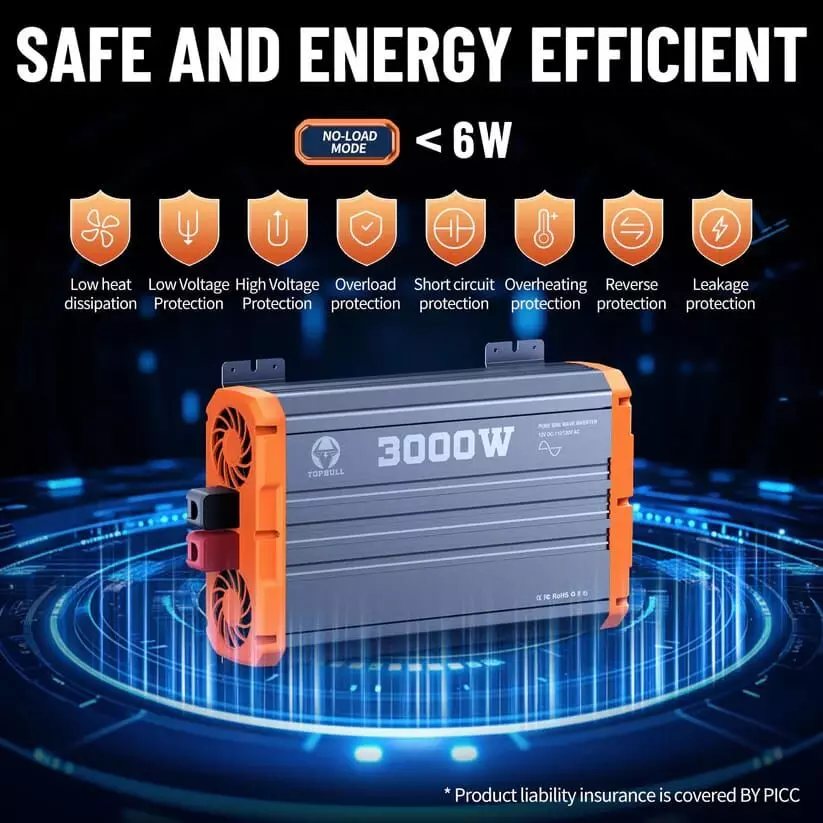Understanding 3000W Pure Sine Wave Inverters: Your Guide to the Best Power Inverters and Battery Choices
image for illustrative purpose

In the world of portable power solutions, especially for RVs, boats, off-grid cabins, or even home backup setups, inverters play a crucial role. Among these, a 3000W pure sine wave power inverter is a popular choice for its balance between power capacity and smooth energy output. This article dives into the details of 3000W power inverter, specifically the pure sine wave type, and helps you find the best battery inverter options and top-rated 3000W power inverters.
Why Choose a 3000W Pure Sine Wave Inverter?
When selecting a power inverter, it's essential to consider your wattage requirements and the type of AC power output. A 3000W inverter provides a robust power capacity, which is generally sufficient for running multiple appliances, including those that require a significant amount of startup power, such as refrigerators, microwaves, and small air conditioning units.
Pure Sine Wave vs. Modified Sine Wave Inverters
There are two primary types of inverters: pure sine wave and modified sine wave.
1. Pure Sine Wave Inverters: These inverters provide a smooth and consistent AC power output, similar to what you receive from the grid. This makes them ideal for running sensitive electronics, such as laptops, medical devices, and audio/visual equipment, without risk of interference or overheating.
2. Modified Sine Wave Inverters: While more affordable, these inverters deliver a less consistent power output. They are suitable for basic appliances but may cause issues with sensitive devices, potentially leading to shortened lifespans or interference.
For those looking for reliability, efficiency, and device protection, the 3000W pure sine wave inverter is a top choice. It ensures stable power, suitable for sensitive and high-wattage devices, making it perfect for an RV, boat, or home backup solution.
How to Choose the Best Battery for a 3000W Inverter
To maximize the performance of a 3000W inverter, pairing it with the right battery is essential. Here are some factors to consider:
1. Battery Capacity: The power draw from a 3000W inverter can be substantial, especially if running multiple appliances simultaneously. To support this load, look for batteries with high amp-hour (Ah) ratings. For instance, a 12V system might require at least 250-300Ah to handle typical usage.
2. Battery Type:
Lithium-ion batteries: Known for their high energy density, lightweight nature, and long lifespan, lithium-ion batteries are an excellent match for a 3000W inverter, especially in mobile setups like RVs.
Deep-cycle lead-acid batteries: Although heavier and with a shorter lifespan than lithium, deep-cycle lead-acid batteries are affordable and effective for shorter-term or stationary applications.
AGM batteries: A type of sealed lead-acid battery, AGM batteries are maintenance-free, reliable, and can be a more cost-effective alternative to lithium.
3. Voltage Configuration: A 3000W inverter draws a high current at lower voltages (e.g., 12V), which can quickly drain your batteries. Opting for a 24V or 48V inverter system, if compatible, can reduce current draw and improve efficiency.
The Best 3000W Inverters on the Market
When shopping for the best 3000W inverter, there are specific features and brands that stand out:
Topbull 3000W Power Inverter
Overview: Known for its competitive pricing and efficient performance, the Topbull 3000W power inverter is a great option for those looking for a dependable pure sine wave option on a budget.
Features: Built-in protection systems, compact design, and user-friendly interface make it an ideal inverter for RV users and those new to off-grid setups.
Pros: Affordable, reliable power output, good for beginners and mid-level users.
Key Features to Look for in a 3000W Inverter
When evaluating inverters, look beyond just wattage. Some features that can significantly impact performance and usability include:
1. Efficiency: Higher efficiency means less energy is lost during the DC-to-AC conversion, allowing your batteries to last longer. Look for inverters with at least 85% efficiency ratings.
2. Safety Protections: An inverter should include overload, over-temperature, and short-circuit protection. This ensures not only the safety of the inverter but also your appliances and battery system.
3. Remote Control and Monitoring: For convenience, especially in RVs or remote setups, inverters with remote control options or displays allow you to monitor and adjust settings easily.
4. Compatibility with Battery Systems: Ensure the inverter matches your battery setup in terms of voltage (e.g., 12V, 24V). This compatibility can improve efficiency and battery life.
Conclusion: Selecting the Right 3000W Pure Sine Wave Inverter and Battery Setup
A 3000W pure sine wave inverter is a powerful and versatile choice for RVs, boats, and even home backup systems. With enough capacity to support essential appliances and delicate electronics, this inverter type offers reliable, stable power. By pairing it with a high-quality battery (such as lithium or deep-cycle AGM) and choosing a reputable brand like Topbull, you can build a dependable off-grid or backup power solution.
Whether you’re an RV enthusiast, a boater, or simply preparing for emergencies, the right inverter and battery combination can provide peace of mind and consistent energy. Investing in a quality inverter and battery system today means fewer interruptions and more flexibility in the future, making it a smart choice for those looking to maximize
off-grid independence.

